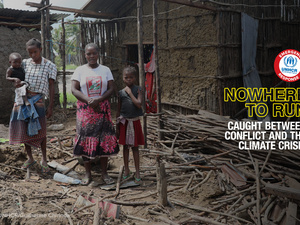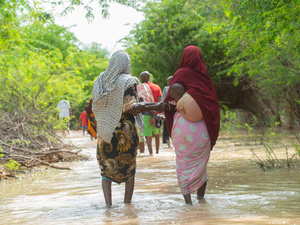Massive floods in Sudan impact thousands of refugees
Looking back at the years he has spent in Sudan, Bak does not remember seeing anything like the recent floods that have wreaked havoc across the country.
“The floods came at night. The water was flowing into my shelter and I could not sleep,”says the 80-year-old South Sudanese refugee, who lives fifty meters from the Blue Nile, in Khartoum’s Sharg Al Neel locality.
He was stranded for days as the area was covered in water.
“The water kept flowing for seven days until it went down. I could not move because I did not want to leave my belongings,” he adds with a sigh.
His belongings include a rusty bedstead, a few pots and metal plates and some personal items. His shelter, made of wooden poles with pieces of cloth and metal sheets for a door, hardly protects him from the elements.
“The floods came at night. The water was flowing into my shelter and I could not sleep.”
“I lost all my clothes and a sack of wheat in the floods,” he adds.
Before UNHCR, the UN Refugee Agency, arranged for a distribution of relief items in the area, Bak’s greatest wish was to receive ‘some plastic sheeting and two galabias’– loose-fitting traditional clothes.
Heavy rains caused flash floods and rivers like the Nile, reached a level of over 17 metres, bursting its banks and leaving thousands – including refugees like Bak,internally displaced people and locals – homeless and in desperate need of humanitarian support.
The UN estimates that at least 800,000 people have been affected with over 100 people killed. Extensive assessments by UNHCR have revealed that some 125,000 refugees and internally displaced people are among those affected.
The most affected states are West, South and North Kordofan, Sennar, Darfur, East Sudan and Khartoum.
Vulnerable refugees and locals alike have been hardest hit by the extreme weather. Many houses, critical water points and latrines across the country have been destroyed or damaged.
Even in areas far away from rivers such as Al Droshab, an area in Khartoum with many unfinished concrete buildings, garbage dumps and humble shelters, thousands were impacted by the torrential rains and strong winds.
South Sudanese refugee Christina was among some 2,000 people affected by the rains in Al Droshab. Her humble shelter could barely protect her family from the elements.
“We were sleeping when the rains came. Our house started leaking everywhere,” she says, recalling the moment when she took her nine children aged between 16 months and 14 years to gather under a stretch of plastic.
“We covered ourselves, but the sheet was leaking too,” adds Christina who was among those who received plastic sheeting, sleeping mats, blankets and jerry cans earlier this week.
Countrywide, UNHCR, together with partners including Save the Children and Sudanese non-profit, Addition to Disaster Assistance and Development(ADD), distributed non-food items to some 170,000 refugees, IDPs and locals.
“I am glad the relief items can alleviate the suffering of some of the most vulnerable people,” says Ahmed Ali, UNHCR’s Assistant Protection Officer, who is coordinating the distribution in the vast Khartoum area.
“I want to rebuild my house, improve my quality of life and send my children to school.”
He stresses the need for more humanitarian assistance, adding that “the needs are huge and the support is short-term.”
He further explains that funding is limited. As of mid-September, UNHCR had received just 38 per cent of the US $274.9 million needed for its operations in Sudan. According to a recent UNHCR report titled, ‘Consequences of Underfunding in 2020’, the South Sudan situation suffers from an even lower funding level of 33 per cent.
Despite the devastating impact that the floods have had on Christina’s life, she is not prepared to give up.
“I want to rebuild my house, improve my quality of life and send my children to school,” she says.










